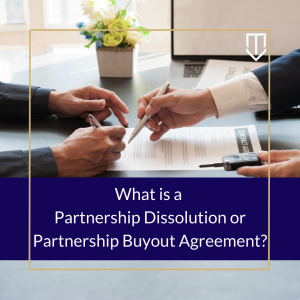

The purpose of this article is to explain what Partnership Dissolutions and Partnership Buyout Agreements are. Understanding the purpose of these contracts is important to business partners attempting to navigate the dissolution or end of their partnership and the loss of a partner. Knowing the differences between a Partnership Dissolution and a Partnership Buyout Agreement is crucial to ensuring the best outcome for your partnership’s end.
What is a “Partnership Dissolution”?
A partnership dissolution is the first step in ending a business relationship between partners in a partnership firm by altering an existing partnership. A partnership is a type of formal relationship between at least two individuals who engage in shared business activity for profit. A partnership dissolution ends the legal relationship between partners. Dissolution can occur because of disputes between partners, departure of a partner from the firm, business failure, bankruptcy, or retirement. California law outlines five ways a partnership can be dissolved.
1. Partnership “At Will”
Dissolution of a partnership at will requires at least half of the partner’s “express will to dissolve”. (Corp. Code, § 16801.) The express will to dissolve a partnership must belong to at least half of the partners and can include partners who have dissociated within 90 days prior. (Id.)
In partnerships comprised of only two individuals, one partner’s withdrawal automatically dissolves the partnership because the remaining individual cannot operate as a partnership alone. (Corrales v. Corrales (2011) 198 Cal.App.4th 221, 227-28.) In this instance, there is no statutory right to a mandatory buyout. (Id.) Instead, the partnership’s assets will be liquidated to ensure creditors receive their full payment. (Id.) Any amount left over after payment to creditors is dispersed evenly between partners. (Id.)
2. Partnership for Definite Term or Particular Undertaking
A Partnership for Definite Term or Particular Undertaking is created for a set period and/or purpose. Unless the majority in interest of partners have agreed to continue a partnership, a Partnership for Definite Term or Particular Undertaking will dissolve in one of three ways: (1) Upon the definite term’s expiration or completion of the undertaking; (2) through the express will of all the partners; or (3) 90 days after a partner’s wrongful dissociation, bankruptcy, incapacity, or death. A Partnership for definite term or undertaking can also be dissolved through an application by transferee. In this instance, a partnership can be dissolved if the court finds it is equitable on application by a transferee of a partner’s “transferable interest”. (Corps.C. § 16801(6).)
3. Dissolution by Event in Partnership Agreement
In some partnerships, the partnership agreement outlines a series of events whose occurrence will result in dissolution. Therefore, if any of the outlined events occur, the partnership dissolves. (Corps.C. § 16801(3).)
4. The Partnership Becomes Unlawful
Like dissolution by events in an agreement, a partnership dissolves when an event occurs which makes the partnership’s continuation unlawful. (Corps.C. § 16801(4).) In some cases, dissolution can be avoided by curing the illegality within 90 days of receiving notice of its occurrence. (Id.)
5. Judicial Decree
If a partner moves to the court, a partnership can be dissolved through a court order finding one or more of the following determinations:
A. The partnership’s continuation is no longer “reasonably practicable” in accordance with the partnership agreement.
B. One or more of the existing partners engaged in behavior related to the partnership making it not reasonably practicable to continue the business relationship.
C. The partnership’s economic purpose is likely to be, or has become, “unreasonably frustrated”. (Corps.C. § 16801(5).)
What is a Partnership Buyout Agreement?
A Partnership Buyout Agreement may be needed in circumstances like those leading to partnership dissolution; whether it be death of a partner, voluntary departure, retirement, or disability, the remaining partner(s) may be able to buy out the departing partner through a partnership buyout agreement. A Partnership Buyout Agreement is an agreement signed by all partners stipulating the circumstances in which one partner may buy out another partner’s business shares. (Corps.C. § 16701.5.)
Ideally, these agreements are drafted at the start of a partnership and articulate the terms of sale and a set sale price. (Id.) A Partnership Buyout Agreement should include each of the following terms. (Id.)
1. Who can buyout a partner’s interest when a buyout is triggered?
Another partner? The partnership itself? An outside third party? Partnership buyout agreements can include terms of sale that are intentionally restrictive so that only the other partner(s) in a partnership can buy the exiting partner’s interest, or so intentionally ambiguous that anyone can buy the share. Most commonly, an ambiguous Partnership Buyout Agreement will include the Right of First Refusal. This means, the exiting partner must offer to sell their interest to the remaining partner(s) before they can attempt to sell to anyone else. The inclusion of the Right of First Refusal ensures that each partner can protect themselves, either by having access to other points of sale when the remaining partners are unable or refuse to purchase the share, or by ensuring no unwanted outside party will enter the partnership.
For example, “Shawn” and “Julie” have an existing partnership together, but Shawn is leaving the partnership. Shawn and Julie have a Partnership Buyout Agreement they created at the beginning of their partnership. The Agreement includes a clause stating the remaining partner has the Right of First Refusal in the instance that the other partner decides to leave. Accordingly, Shawn offers Julie the chance to buyout his ownership shares before anyone else. Julie, not wanting to leave the partnership but unable to afford Shawn’s interest, refuses Shawn’s offer to buy. Upon Julie’s refusal, Shawn sells his interest to an outside party named John. John becomes Julie’s new partner, allowing Shawn to exit the partnership as he wished.
2. What is the Value of the Exiting Partner’s Interest?
Oftentimes, including an explicit buyout sale price at the start of a partnership is an incredibly difficult feat because partners cannot predict the future success of their business. (Corps.C. § 16701(b).) Because of this, buyout agreements avoid setting a fixed price that can ultimately become unfair to the exiting partner by including a buyout provision that articulates a specific formula to calculate the sale price at the time of the partner’s exit based on the (1) the businesses’ current value after liquidation; (2) its equity value; and (3) the future flow of distributions at their present value. (Id.) Using this formula, partners can ensure fair compensation and better navigate what is often the most contentious part of the buyout process.
If a Partnership Buyout Agreement does not exist, partners must rely on the remedies provided by California law to dissolve a partnership entirely or simply force a partner out. Remedies are also available in the instances of wrongful dissociation. (Corps.C. § 16701(c).) These remedies can include seeking damages, indemnifying the partner, or deferred payment of the sale price. (Corps.C. § 16701(c)-(g).)
Conclusion
Partnership Dissolutions and Partnership Buyout Agreements both lead to the departure of an existing partner from a partnership but are not the same process. Partnership Dissolutions end in termination of the partnership while Partnership Buyout Agreements can result in the partnership’s survival. The Underwood Law Firm has a team of experienced lawyers who can help guide you through your partnerships end and help you pursue solutions to ensure you recover the entirety of what you are legally entitled to. We are here to help.










